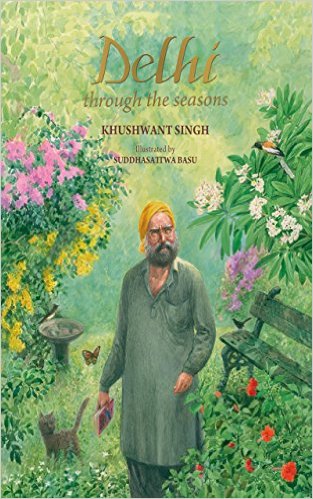A must for Delhiwalahs, and others!
Title:Delhi, through the Seasons
Author:Khushwant Singh
PP:112
Price:999
Publisher:Harper Collins
Cities don’t just comprise public infrastructures like schools, buildings, roads, airports and hospitals or privately-owned tall and small houses of brick and mortar. Cities, in their true definition, consist of much more than what we can see. That is their typical environment and seasons which are easily felt than are seen. Any city sans its own seasonal specialities, to me, is unthinkable. Why Lucknow is different from Pune or Mysore from Vadodra is mainly because of it’s historical background and its seasonal variety, rather than its built infrastructure!
If I have chosen this wonderfully illustrated book, Delhi, through the Seasons for reviewing with more than one consideration. But first, its celebrated author Khushwant Singh who has not written books on subjects pertaining to urbanisation and environment, a strong reason that aroused my curiosity. Essentially, Khushwant Singh’s keen observations as a seasoned Delhite have impressed me as a reader moret than a reviewer. I wish to share that delight with you. Khushwant was a towering scholar we all know. So when he writes about this city which he loved the most, while breaking away from the typical approach of other authors writing about a city’s history-geography-politics, it’s time we stop and take notice.
So what are the new things he unfolds before us through the colourful pages and informative content of the book? Well, Singh starts off from January and goes up to December and beautifully presents each month’s seasonal specialities in front of us, with a dash of bird life, vegetation and environment’s USPs. The monthly chronology reveals before us a treasure of Delhi’s highs and lows in terms of different seasons. I must say this book is a very positive book, which takes you away from the daily tensions and negativity. It takes you on to a different plain. Sardar Khushawant watches trees and shrubs, inhales the bountiful fragrance of flowers of the months, gets completely lost in watching birds and butterflies flying around his garden (in Sujan Singh Park area) in a given month just like a child and records his intelligent observations about the surroundings through the twelve months of the year—and sometimes, he tells his own story like a meticulous diarist, at times he weaves poems by Kalidasa, Guru Nanak or Rabindranath Tagore, in his narratives like a true scholar to take us around nature in its fullest bloom.
My experience, upon reading this riveting ‘nature lover’s diary’ has been that most of us have actually forgotten to notice the beautiful things scattered around us. Pollution, traffic, unruly people notwithstanding, capital Delhi has a lot to cheer about, tells this book of wonder, noting the beauty of many fairs and festivals celebrated in the country; telling the story of clouds, of what their shapes and movements mean; investigating why hailstorms come in spring and early summer and not in winter; writing about how birds communicate with each other and why their calls vary with the seasons.
I am quite amazed—as you would perhaps be while reading it—to know about his in-depth knowledge about birds species, trees species, typicality of a given animal coupled with his outstanding sense of appreciating the nature in a city like Delhi, often at the receiving end of urban experts and journalists. In the beginning, he writes, ‘for the last many years I have maintained a record of the natural phenomena I encounter every day. However, my nature-watching is done in a very restricted landscape, most of it in my private back garden’, he candidly inform us. ‘It is a small rectangular plot of green enclosed on two adjacent sides by a barbed wire fence covered over by Bougainvillaea creepers of different hues. The other two sides are formed by my neighbours’ and my own apartments. He had fenced himself off by a wall of hibiscus; I have four ten-year- old avocado trees, perhaps the only ones in Delhi, which between them yield no more than a dozen pears every monsoon season; and a tall eucalyptus smothered by a purple bougainvillaea...’
It’s after this brief introduction he goes on one by one observing peculiarities of each month, with some awe-inspiring paintings in the subsequent pages by Suddhasattwa Basu, easily among the best present-day natural phenomena painters in the country. His creative genius is on full display throughout the book and adds to the richness and readability of the same.
You get a rare glimpse of Delhi’s green and beautiful side in this book. So please don’t make the mistake of expecting references to politics, geography, garbage dumps or polluted air, traffic and contaminated Yamuna in the page of this superb book. You would be hugely disappointed. The book came into the market a little after Khushwant Singh had departed from this world and therefore, I rate this book as his last but invaluable gift to Delhi. Treasure it!
Abhilash Khandekar
National Political Editor of Dainik Bhaskar.
He can be followed on Abhikhandekar1; This email address is being protected from spambots. You need JavaScript enabled to view it.




